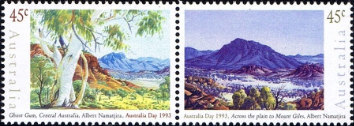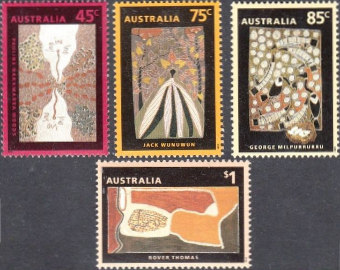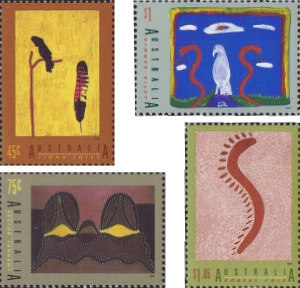History
Timeline results for 1970 to 1999
Found 232 results for your search. Showing page 9 of 12.
Year from 1970, year to 1999
1991
-
Legislation providing for land rights in Queensland is passed - the Aboriginal Land Act 1991 and the Torres Strait Land Act 1991. The laws are greatly inferior to the standard set by the Northern Territory legislation.
-
The Upper House in Tasmania rejects land rights legislation for Aboriginal people.
-
The Council for Aboriginal Reconciliation is set up, funded by the federal government, with cross-party support. The parliament noted that there had not been a formal process of reconciliation to date, “and that it was most desirable that there be such a reconciliation” by 2001.
-
Support for a treaty is not unanimous, but wide political support continues for reconciliation. Through 1990 and 1991, cross-party support develops for a formal process of reconciliation to be led by a council of prominent Australians, and the government establishes the Council for Aboriginal Reconciliation on 2 September 1991.
1992
-
The High Court of Australia hands down its landmark decision in Mabo v Queensland (Mabo case, Mabo decision). It rules that native title exists over particular kinds of lands - unalienated Crown lands, national parks and reserves - and that Australia was never terra nullius or empty land.
-
Torres Strait Islander flag designed.
-
Minister for Aboriginal Affairs invokes the Aboriginal and Torres Strait Islander Heritage Act to protect women’s sites near Alice Springs, threatened by a dam proposed by the Northern Territory government.
-
Mandawuy Yunupingu, leader of the Aboriginal band Yothu Yindi, receives the Australian of the Year award. ⇒ Famous Aboriginal people
-
The Council for Aboriginal Reconciliation issues its Strategic Plan for the next three years.
-
Maurice Rioli (Australian Labor Party), from Melville Island is elected to the Northern Territory Legislative Assembly representing the electorate of Arafura.
-
The remains of Mungo Lady return from the the Australian National University to a temporary keeping place at Lake Mungo [1] in south-western New South Wales, the land of the to the Paakantji, Mathi Mathi and Ngiyampaa people. The remains are said to be the oldest human remains to be found anywhere in the world that had been ritually cremated.
-
The first Survival Day concert is held in Sydney.
-
Labor Prime Minister Paul Keating’s Redfern speech at the launch of the International Year of the Indigenous People acknowledges past wrongs perpetrated against Aboriginal people.
1993
-
Due to growing public concern and pressure from Indigenous people the Aborigines Welfare Fund is frozen, ending deductions to the fund.
According to historians, Native Affairs Department budgets were frequently topped up with money from the fund and, during the Depression, the government took more than $5 million to cover consolidated revenue deficits [2].
By the time the welfare fund was frozen, all that remained was about $5 million. Up to 2008 it has accumulated another $5.8 million in interest [2].
-
International Year of Indigenous People.
-
To celebrate the International Year of Indigenous People, Australia Post issues two stamps for Australia Day that celebrate Aboriginal painter Albert Namatjira and his watercolour style. The stamps show a ghost gum and Mount Giles.

Albert Namatjira was famous for his use of water colours. -

The common theme of these paintings is 'Dreaming'. Australia Post issues a set of four stamps to celebrate the International Year of Indigenous People showing paintings by Aboriginal artists. They are: Wild Onion Dreaming by Pauline Nakamarra Woods (45c), Yam Plants by Jack Wunuwun (75c), Goose Egg Hunt by George Milpurrurru (85c) and Kalumpiwarra-Ngulalintji by Rover Thomas ($1).
-
The Wik Peoples make a claim for native title in the Federal Court of Australia for land on the Cape York Peninsula in Queensland. Native Title Act does not pass through parliament until December 1993.
-

This set showcases the work of four different Aboriginal artists. A second set of stamps celebrates the International Year of Indigenous People with the designs for this issue based on four Aboriginal artists' work: Black Cockatoo Feather by Fiona Foley (45c), Ngarrgooroon Country by Hector Jandany (75c), Ngak Ngak by Ginger Riley Munduwalawala ($1) and Untiled by Robert Cole ($1.05).
-

In a first for Vogue, Aboriginal model Elaine George of Brisbane becomes the cover girl for the September issue of Vogue Australia 1993, leading to a career as an international model. Elaine, a descendant from the Arakwal people of Byron Bay, was discovered as a 17-year-old at Dreamworld, a Gold Coast amusement park, by freelance photographer Grant Good. The issue became the highest selling Vogue in the then 34-year history of Australian Vogue.



